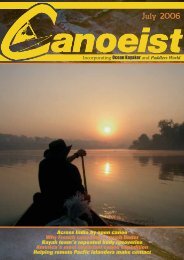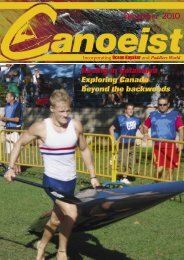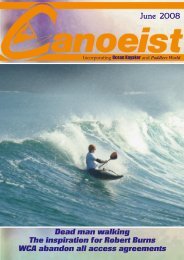November 2006 - Canoeist Magazine
November 2006 - Canoeist Magazine
November 2006 - Canoeist Magazine
Create successful ePaper yourself
Turn your PDF publications into a flip-book with our unique Google optimized e-Paper software.
The Barefoot Navigator<br />
Jack Lagan<br />
Adlard Coles Nautical, 38 Soho Sq,<br />
London W1D 3HB<br />
0 7136 7429 6<br />
<strong>2006</strong><br />
240 x 170mm<br />
148 pages, paperback<br />
£14.99<br />
It seems increasingly as if the typical<br />
yachtsman plugs his GPS into his laptop<br />
and waits for it to tell him which way to<br />
go to the next waypoint. ‘Barefoot<br />
navigation in its purest form is a<br />
collection of technology-free techniques<br />
based upon observation of the natural<br />
world’ says this book. As such, it is much more akin to the methods<br />
used by those of us who are limited in the kit we are able to carry,<br />
regardless of whether we wish to carry it.<br />
The first part of the book is an admiration of the voyages of the<br />
ancients, particularly the wide ranging Polynesian canoe voyages,<br />
carried out without any navigation equipment and with nothing<br />
written down, so that the charts and all relevant information were<br />
always in the navigator’s head.<br />
The author comments that these canoes were allowed to bend as<br />
there was not the technology to make rigid crossmembers, a suggestion<br />
that should be considered with the fact that Inuit kayak frames often<br />
had bone articulating joints included to assist flexing.<br />
The major and most valuable part of the book is no-tech navigation,<br />
navigating without equipment by using the sun, wind, waves, stars,<br />
clouds, birds and even water quality to give clues. Often it relates to<br />
ocean out of sight of land but some is applicable much closer inshore.<br />
The final parts suggest how to make your own economical<br />
equipment and how to assemble a grab bag to take when abandoning<br />
ship, of limited value if space on board is the criterion.<br />
The humour is dry. ‘The resulting, now moving, build-up of water<br />
curls over at the crest and spews plastic ironing boards and young<br />
people who talk a strange language onto the beach...<br />
‘For the navigator, this increased height of a series of waves can be<br />
an indication of shallowing and, therefore, the possible proximity of<br />
low-lying land and a bar serving drinks.’<br />
Illustration is with black and white drawings, printable copies of<br />
which can be downloaded from the author’s website if you wish to<br />
adorn your boat.<br />
Finally, it is worth bearing in mind the quotation of 1770 by<br />
astronomer Jean Dominique Cassini, ‘It is far better to have absolutely<br />
no idea of where one is - and to know it - than to believe confidently<br />
that one is where one is not.’<br />
This differs from every other navigation book and contains<br />
important principles overlooked by the official yachting navigation<br />
texts.<br />
Emrhys Barrell<br />
Adlard Coles Nautical<br />
0 7136 7636 1<br />
1993. 3rd edition <strong>2006</strong><br />
230 x 160mm<br />
214 pages, paperback<br />
£15.99<br />
The significant change for the latest edition of this book is that it is<br />
now in full colour, many of the pictures being taken from shots closely<br />
related to those shown previously in black and white.<br />
28<br />
Inland Waterways Manual<br />
CANOEIST <strong>November</strong> <strong>2006</strong><br />
Reviews of new books<br />
and publications<br />
Since the last edition (May 03, p38) the<br />
cost of powered craft seems to have risen<br />
sharply. There are few changes to the text<br />
although there is now a section on living<br />
aboard full time and there is enthusiasm for<br />
night time travel. As before, it is not a book<br />
which tells you what you should be doing<br />
so much as one which tells you what larger<br />
craft are doing and why their crews are<br />
likely to behave in certain ways, ways<br />
which may effect you.<br />
There are fewer changes to the gazetteer<br />
of waterways than might have been<br />
expected, mostly a change of tense where<br />
an anticipated restoration has now taken place.<br />
The Adlard Coles Book of Knots<br />
Peter Owen<br />
Adlard Coles Nautical<br />
0 7136 8152 7<br />
1999. 3rd edition <strong>2006</strong><br />
A5<br />
96 pages, paperback<br />
£7.99<br />
The first change with the third edition of<br />
this book is the title. Previously it was The<br />
RYA Book of Knots (Oct 04, p24).<br />
Because it relies on drawings it is much<br />
easier to follow than some other knot books.<br />
An extra colour has been added to the<br />
drawings this time, making them clearer again. Otherwise, the<br />
alterations are only cosmetic with no change of content, other than to<br />
add colour photographs at the starts of chapters, ornamental rather than<br />
useful.<br />
As these knots, bends, loops, hitches, seizings, splicings and more are<br />
used in a marine situation it is useful to have some nautical terms<br />
explained. Furthermore, advice on rope materials and layups, tools and<br />
stopping fraying of ends are further important subjects which are not<br />
always easy to source.<br />
Turkish Waters & Cyprus Pilot<br />
0 85288 841 4<br />
1984. 7th edition <strong>2006</strong><br />
358 pages, hardback<br />
Italian Waters Pilot<br />
Rod Heikel<br />
Imray Laurie Norie & Wilson Ltd, Wych House, The Broadway, St<br />
Ives, Cambs PE27 5BT<br />
0 85288 913 8<br />
1983. 7th edition <strong>2006</strong><br />
A4<br />
453 pages, hardback<br />
The Turkish coast is still largely undiscovered by boaters although<br />
holiday villages (to which the author is opposed) are springing up<br />
along the coast. Of Bodrum he says ‘the place has become a sort of<br />
“little England”, in the pejorative as well as the literal sense, with signs<br />
everywhere for “English pubs”, “fish and chips”, “English breakfasts”,<br />
and everything else you would want to sail a hundred miles to get<br />
away from.’<br />
The Turkish book covers the Sea of Marmora, Mediterranean and<br />
Black Sea coasts plus the whole of Cyprus, despite the objections of





